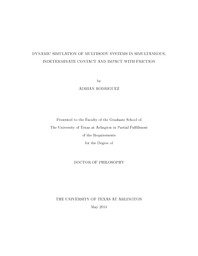
ATTENTION: The works hosted here are being migrated to a new repository that will consolidate resources, improve discoverability, and better show UTA's research impact on the global community. We will update authors as the migration progresses. Please see MavMatrix for more information.
Show simple item record
| dc.contributor.author | Rodriguez, Adrian | en_US |
| dc.date.accessioned | 2014-07-14T20:21:49Z | |
| dc.date.available | 2014-07-14T20:21:49Z | |
| dc.date.issued | 2014-07-14 | |
| dc.date.submitted | January 2014 | en_US |
| dc.identifier.other | DISS-12588 | en_US |
| dc.identifier.uri | http://hdl.handle.net/10106/24399 | |
| dc.description.abstract | This research is focused on improving the solutions obtained using theory in contact and impact modeling. A theoretical framework is developed which can simulate the performance of dynamic systems within a real world environment. This environment involves conditions, such as contact, impact and friction. Numerical simulation provides an easy way to perform numerous iterations with varying conditions, which is more cost effective than building equivalent experimental setups. The developed framework will serve as a tool for engineers and scientists to gain some insight on predicting how a system may behave. The current field of research in multibody system dynamics lacks a framework for modeling simultaneous, indeterminate contact and impact with friction. This special class of contact and impact problems is the major focus of this research. This research develops a framework, which contributes to the existing literature. The contact and impact problems examined in this work are indeterminate with respect to the impact forces. This is problematic because the impact forces are needed to determine the slip-state of contact and impact points. The novelty of the developed approach relies on the formation of constraints among the velocities of the impact points. These constraints are used to address the indeterminate nature of the collisions encountered. This approach strictly adheres to the assumptions of rigid body modeling in conjunction with the notion that the configuration of the system does not change in the short time span of the collision. These assumptions imply that the impact Jacobian is constant during the collision, which enforces a kinematic relationship between the impact points. The developed framework is used to address simultaneous, indeterminate contact and impact problems with friction. In the preliminary stages of this research, an iterative method, which incorporated an optimization function was used obtain the solutions for numerical solution to the collision. In an effort to improve the time and accuracy of the results, the iterative method was replaced with an analytical approach and implemented with the constraint formulation to achieve more energetically consistent solutions (i.e. there are no unusual gains in energy after the impact). The details of why this claim is valid will be discussed in more detail in this dissertation. The analytical framework was developed for planar contact and impact problems, while a numerical framework is developed for three-dimensional (3D) problems. The modeling of friction in 3D presents some challenging issues that are well documented in the literature, which make it difficult to apply an analytical framework. Simulations are conducted for a planar ball, planar rocking block problem, Newton's Cradle, 3D sphere, and 3D rocking block. Some examples serve as benchmark problems, in which the results are validated using experimental data. | en_US |
| dc.description.sponsorship | Bowling, Alan P. | en_US |
| dc.language.iso | en | en_US |
| dc.publisher | Mechanical Engineering | en_US |
| dc.title | Dynamic Simulation Of Multibody Systems In Simultaneous, Indeterminate Contact And Impact With Friction | en_US |
| dc.type | Ph.D. | en_US |
| dc.contributor.committeeChair | Bowling, Alan P. | en_US |
| dc.degree.department | Mechanical Engineering | en_US |
| dc.degree.discipline | Mechanical Engineering | en_US |
| dc.degree.grantor | University of Texas at Arlington | en_US |
| dc.degree.level | doctoral | en_US |
| dc.degree.name | Ph.D. | en_US |
Files in this item
- Name:
- Rodriguez_uta_2502D_12588.pdf
- Size:
- 4.139Mb
- Format:
- PDF
This item appears in the following Collection(s)
Show simple item record


